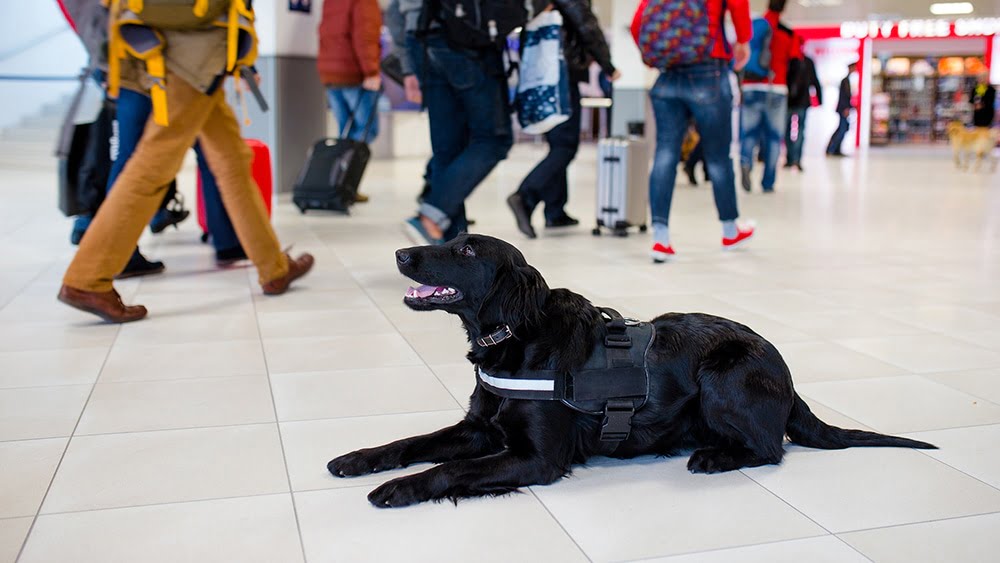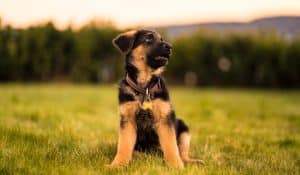We at ProDog, being totally obsessed with all things dog related, love this time of year.
Why? Because it’s Dog appreciation week. The 23rd to 30th April is an opportunity to celebrate the power, beauty, intelligence and total wonderfulness of our faithful friends. The best excuse to get even more dog devoted, and admire the wonderment of the canine species.
As you’ll know by now our mission is in creating optimum natural nutrition for our fur friends (Find out more through our RAWbellion page).
We have a whole range of four legged customers, all of which we adore. Many different, shapes, sizes and occupations: competition, sports, beloved friends, working dogs and service dogs… So many we could spend all day, every day, this week writing appreciative words about, but we sadly don’t have the time. We decided to narrow things down and dedicate our adoration for this year’s appreciation week to service dogs. More specifically those service dogs who use their sense of smell to make the world a better place.
Dogs have been known as “man’s best friend” for centuries. They’re the animals known to have unconditional loyalty to their hooman, who give their companionship, energy, love and needing very little in return. So, it makes sense that these wonderful wet nosed creatures were chosen to use their superpowers to make a difference in the world.
In recognition of this we wanted to share with you some of the ways man’s best friend is serving our planet, raise awareness of the miraculous work they do every single day and illustrate why we think detection dogs are one breed of super hero in the canine world to celebrate.
Detection Dogs
Dog superpowers get no more super than their sense of smell. Our canine friends can be trained to sniff out all kinds of things and use their skills to help in: combating crime, medical emergency, crisis, search and rescue.
Our canine bestie’s have up to 300 million olfactory receptors in their noses, when you compare that to a human being’s miserly six million you’ll begin to understand the reason for this superpower. The part of a dog’s brain that’s devoted to analysing smells is, proportionally speaking, 40 times greater than ours.
How much more powerful is their sense of smell?
Alexandra Horowitz in her book “Inside a dog”, writes that while we might notice if our coffee has had a teaspoon of sugar added to it, a dog could detect a teaspoon of sugar in a million gallons of water, or two Olympic-sized pools worth.
Amazing right?
We were astounded to find out that detection dogs are trained to follow so many scents
[one_second]
- Human remains
- Cancer detection
- Drugs
- Endangered animal species
- Explosives
- Fire accelerants (e.g., arson investigation)
- Firearms
- Hypoglycemic (low blood sugar) emergencies in humans
- Invasive species (e.g., quagga mussel)
- Currency (e.g. large amounts of money carried by passengers in airports that should be declared to customs before travel)
[/one_second]
[one_second]
- Mobile phones (e.g. as contraband in prisons)
- USB drives
- SIM cards
- Mold
- Plants, animals, produce, and agricultural items that have to go through customs
- Gourmet Fungi, such as Truffles
- Wildlife scat
- Termites
[/one_second]
Are you in total awe like us after reading that list? Some are common knowledge, some you’ll know dogs have been sniffing out for decades, others are a little more recent such as cancer detection. We were so mesmerised with the value medical detection dogs give to the world we wanted to tell you about them in a little more detail.
Medical Detection Dogs
Since the 1860’s when Florence Nightingale found animal companionship to significantly impact the well-being of her patients, dogs have been used in many capacities to help people recover from and manage illness, disability, and other conditions.
There are 2 key roles in which man’s best friend uses their nose to help in keeping us hoomans healthy. Medical Assistance dogs and Bio-Detection dogs.
Medical assistance dogs are trained to use their amazing sense of smell to identify minute odour changes, stemming from: changes in hormones, blood sugar levels, airborne allergens, recognising heart abnormalities that could signal a heart attack and other physiological changes which indicate potential for medical emergency.
Dogs are currently working for people with:
- Type 1 diabetes
- Postural Orthostatic Tachycardia Syndrome (PoTS)
- Addisons Disease
- Severe allergies
- Other endocrine disorders
- Episodes of sudden health deterioration
These amazing dogs give an alert to their hooman when their superpowers notice changes in odour, which allows preventative action to be taken therefore averting onset of serious health crisis. These woofers provide a huge amount of peace of mind for their families and assist our NHS service by reducing the need for emergency treatment.
The phenomenon that are Bio-Detection dogs is a relatively new field. Truly mesmerising to know that our four-legged friends are being trained to detect diseases, such as cancers, neurological diseases and bacterial infections much earlier than is currently possible through standard medical testing. All diseases are associated with biochemical changes that cause changes in odours emanating from our bodies.
Over the last decade studies have indicated some extremely promising results with high levels or accuracy. With current NHS approved clinical trials taking place in the UK we wait to celebrate these awesome canine super heroes in years to come for their truly astounding skills.
Search and Rescue Dogs
Let’s hear you howl from the roof tops for our next group of canine sniffer superstars. Those wonderful woofers who spend their days diligently using their super powered noses to rescue us hoomans from potentially life-threatening environments.
Search and Rescue dogs (SAR) are trained to help in a number of different scenarios: wilderness tracking, natural disasters, mass casualty events, and locating missing people.
They’re trained to detect human scent through evaporated perspiration, respiratory gases, decomposition gases, human tissues & cells from a distance of 50 yards up to 1/4 mile, and anything from 5 – 14 days old scent. The variables are dependent on conditions such as: Wind direction, objects between dog and scent, weather, training and temperature.
These marvellous canines are categorised into 2 groups; air scenting search dogs or scent specific trailing dogs.
Air Scenting Search Dogs don’t identify specific scents, they’re trained to search out human scent but not look for a specific person. They will look for any humans within the search area.
Once the dog finds a missing person they will return to their handler and ‘indicate’ with a bark or by jumping up at them. The handler will then issue a ‘show me’ command and the dog will lead them to their find.
Scent Specific Trailing Dogs are trained to track specific people, they are given an article of the missing persons clothing and will then hunt for a trail that matches that scent.
Once the dog finds the scent they will ‘indicate’ the trail to the handler and then they will follow the trail to the missing person.
Most SAR dogs live and train with their handler. It takes about 600 hours of training for a dog to be field ready. Once field ready they need once-weekly training sessions (4-8 hours) along with frequent focus sessions (5-60 minutes, 3 or more times per week).
Our four-legged super heroes do have a natural inclination to locate scents and SAR training enhances this innate desire by letting a dog know which scent to locate and where this scent might be.
Training is in the form of a game. To these dynamic dogs the serious business of search and rescue is play. Of course, being a dog lover, you’ll know play is the most serious thing in their world. Just notice how long your faithful friend would play fetch with a tennis ball if there were no distractions.
SAR trained dogs have to be encouraged to perform tasks that are not part of his instinctive repertoire and to always focus on the task at hand. So that means not being distracted from their mission by anything at all, even other dogs or tasty treats.
These dogs maintain vigilance and dedication to the search through all types of weather conditions, with all kinds of sensory disturbance and navigate treacherous terrain whilst maintaining total focus on the instruction their handler has given.
When you think about it, the level of concentration, focus and dedication of these dogs is admirable. Typically, a SAR organisation will be alerted by emergency services to incidents such as: a missing child, a lost group of hikers, an avalanche, a bombed building, an earthquake, a new tip in a crime that places a victim’s body in a particular lake.
Once at the scene, think about all that would be going on; people and other dogs, distraught family members, reporters, flood lights, bullhorns, vehicles; these wonderful dogs obedience is tested to the limit with this level of distraction.
Remarkable right?
Can you see now why we thought detection dogs and their magnificent noses deserve some recognition?
The appreciation we have for service dogs, along with all working dogs is the reason we do what we do. We at ProDog are thrilled we have the opportunity to help all dogs live life thriving. We’re especially honoured that whilst service dogs are dedicating their canine powers to helping people. We’re helping them by making sure they perform their duties with a feeling of peak vitality every day.
Shout out to all the professional scent sniffers, using your wondrous noses to make this world a safer, healthier place.





0 comments